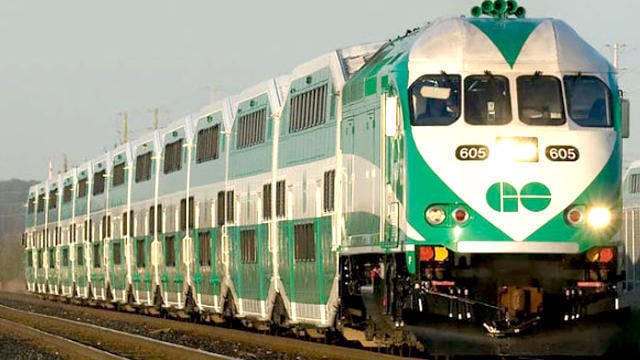Plans for New Milton GO Station Announced
Published November 15, 2017 at 2:02 pm

A new building, more parking, and bike storage are in the redevelopment plans for the Milton GO station.
“This region is growing and so is demand for public transit,” said Minister of Transportation Steven Del Duca.
A new building, more parking, and bike storage are in the redevelopment plans for the Milton GO station.
“This region is growing and so is demand for public transit,” said Minister of Transportation Steven Del Duca.
The transportation minister and Halton MPP Indira Naidoo-Harris were at the Milton GO station on Wednesday morning to announce the next steps to design, build and finance the redevelopment.
The Milton GO station redevelopment and expansion will include: A new station building; an upgraded parking lot with additional 850 parking (bringing the total to 2,300 spaces); reconfiguration of parking lot layouts, bus loop, and passenger pick-up/drop-offs; accessible connections to train and bus platforms; upgraded platforms and infrastructure to support future layover of trains; improved pedestrian connections and bicycle storage.
“We are investing in greater convenience and comfort for commuters with improvements to station capacity, accessible connections to train and bus platforms, new multi-use paths for pedestrians and cyclists, and safety upgrades to lighting and PA systems,” said Del Duca.
“These station expansions are just part of our plan to keep Ontario moving with a future-ready transportation network.”
This project is part of the largest rail project in Canada as Ontario transforms GO from a commuter transit system to a regional rapid transit system.
Weekly trips across the entire GO rail network will grow from about 1,500 to nearly 6,000 by 2024-2025, with more frequent rush-hour service coming to the Milton line.
“These investments will have a significant impact on the lives of commuters in our growing area,” said Naidoo-Harris.
“The addition of 850 parking spaces, along with major changes to the GO train station, bus loop, pathways and passenger pick-up zones, will make commuting easier and more convenient for transit users. I am excited about these key expansions and our government’s commitment to public transit in the Milton corridor.”
Mayor Gord Krantz was also on hand for the press conference.
“Milton council and residents welcome today’s announcement of plans to proceed with GO station enhancements, including improved pedestrian access, additional surface parking and easier connections to Milton Transit,” said Krantz.
“These enhancements bring us one step closer to all-day, two-way GO Train connections which are essential for meeting the needs of our growing community.”
Customers at Milton and Meadowvale GO stations will see new station buildings.
It’s “an exciting change as we make it easier to get to our stations with more parking, better bus/train connections, improved cycling and better pedestrian access,” said Metrolinx president and CEO Phil Verster.
“This is all part of our huge construction program to expand GO Transit and to make using transit better and easier.”
Ontario is investing $21.3 billion to transform GO Transit from a commuter transit service to a regional rapid transit system.
Metrolinx and Infrastructure Ontario (IO) have now issued a Request for Qualifications (RFQ) for interested parties to design, build and finance the Milton Corridor project, including redevelopment of the Milton GO Station.
The RFQ is the first step in the procurement process to select a team to deliver the project. IO and Metrolinx will evaluate submissions to prequalify project teams with the relevant design and construction experience. Teams that qualify will be invited to respond to a request for proposals in 2018. Interested companies must register with merx.com to download the RFQ.
Other work on the corridor includes redevelopment of the Meadowvale GO Station, and a new Station Operations West Facility to accommodate future office, warehouse and parking needs for GO operations.
The project is being delivered using Infrastructure Ontario’s Alternative Financing and Procurement model, which transfers appropriate risks associated with design, construction and financing of the project to the private sector.
insauga's Editorial Standards and Policies advertising





